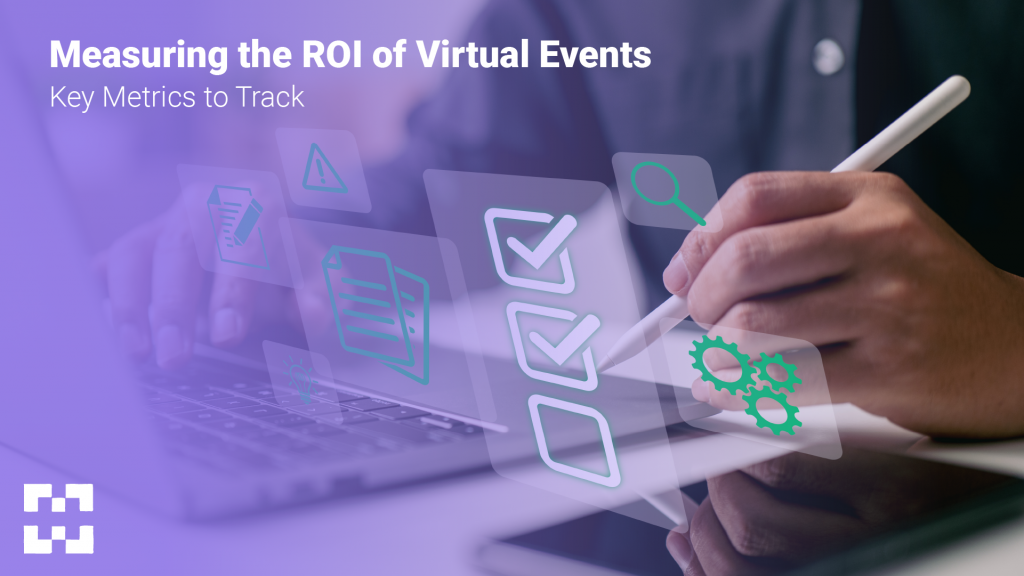
Discover the essential metrics to measure the return on investment (ROI) of virtual events. This comprehensive blog post explores key metrics such as registration and attendance, engagement metrics, lead generation and conversion, social media reach and engagement, cost analysis, and revenue generation.
Virtual events have become an integral part of the business landscape, allowing companies to connect with audiences in a convenient and cost-effective manner. However, as with any marketing initiative, measuring virtual events’ return on investment (ROI) is crucial to determine their effectiveness and make data-driven decisions for future endeavours.
In this blog post, we will explore the key metrics that organizations should track when measuring the ROI of virtual events. By understanding these metrics and their significance, businesses can gain valuable insights into the success of their virtual events and optimize their strategies for better outcomes.
Key Metrics to Track to Measuring the ROI of Virtual Events
Registration and Attendance
One of the primary metrics to track when measuring the ROI of virtual events is registration and attendance. The number of registrations signifies the level of interest and engagement generated by the event. Additionally, tracking attendance during the event provides insights into the actual participation and the effectiveness of marketing efforts in driving attendance.
To measure registration and attendance, consider using a reliable event registration platform that provides real-time data. Compare the number of registrations with your initial goals and track the attendance rate to determine the percentage of registered participants who attended the event. This metric helps you assess the reach and impact of your virtual event.
Engagement Metrics
Engagement metrics are essential for evaluating the level of interaction and interest generated during a virtual event. Tracking these metrics allows you to gauge the effectiveness of your event in capturing and retaining attendees’ attention. Some key engagement metrics to monitor include:
Average viewing duration: This metric calculates the average time attendees spend actively engaged with the event content. It helps you understand if your sessions are compelling and whether attendees find value in the content provided.
Polls and surveys: Interactive features such as polls and surveys provide valuable insights into attendees’ preferences and opinions. Tracking the response rates and analyzing the data collected can help you understand your audience better and tailor future events to their needs.
Chat and Q&A activity: Monitoring the chat and Q&A activity provides a measure of attendee engagement and allows you to address questions or concerns in real-time. A vibrant chat session indicates active participation and involvement, which can contribute to a positive event experience.
Lead Generation and Conversion
Virtual events offer excellent opportunities for lead generation, making it crucial to track the metrics associated with this aspect. Consider the following metrics to measure lead generation and conversion:
Lead capture rate: This metric measures the percentage of attendees who provided their contact information, such as email addresses or phone numbers. It indicates the effectiveness of your event in capturing leads for further follow-up and nurturing.
Qualified leads: Assess the quality of leads generated by evaluating their fit with your target audience and their potential to convert into customers. This metric helps you understand the value of your event in attracting potential customers.
Conversion rate: Track the number of leads that convert into paying customers or take the desired action after the event, such as purchasing a product or subscribing to a service. This metric directly measures the success of your event in driving tangible business outcomes.
Social Media Reach and Engagement
The impact of virtual events extends beyond the event platform itself. Tracking social media metrics allows you to measure the event’s reach and impact on different channels. Consider the following metrics for social media measurement:
Impressions and reach: These metrics quantify the number of times your event content was displayed and the potential audience reached. By tracking impressions and reach on social media platforms, you can understand the amplification effect of your event and its ability to generate buzz.
Shares and mentions: Monitor the number of shares and mentions your event receives on social media. This metric helps gauge the level of engagement and interest among attendees and their willingness to promote your event to their networks.
Hashtag performance: If you have a dedicated event hashtag, analyze its usage and performance across various social media platforms. This metric provides insights into the level of conversation and community building associated with your event.
Cost Analysis and Revenue Generation
To accurately measure the ROI of virtual events, it’s crucial to conduct a thorough cost analysis and assess the revenue generated. Consider the following metrics for cost analysis and revenue measurement:
Event expenses: Calculate the total expenses incurred in organizing the virtual event, including platform fees, speaker fees, marketing costs, production expenses, and any other associated expenses. This metric provides an understanding of the investment made and helps determine the cost-effectiveness of the event.
Sponsorship and exhibitor revenue: If your virtual event involves sponsorships or exhibitor booths, track the revenue generated from these sources. Evaluate the effectiveness of your sponsorship packages and exhibitor opportunities in attracting revenue and providing value to your partners.
Ticket sales or registration fees: If your event requires ticket sales or registration fees, analyze the revenue generated from these sources. Compare the revenue against your event expenses to determine the event’s profitability.
By conducting a comprehensive cost analysis and assessing revenue generation, you can accurately measure the ROI of your virtual event and make informed decisions about future investments in similar endeavours.
Conclusion
Measuring the ROI of virtual events is essential for businesses to evaluate their impact, make data-driven decisions, and optimize future event strategies. When you use Best Platform for Virtual Conference like HuddleXR, you can easily measure the ROI of virtual events.
By tracking key metrics such as registration and attendance, engagement metrics, lead generation and conversion, and social media reach and engagement, organizations can gain valuable insights into the success of their virtual events.
Moreover, by analyzing these metrics in conjunction with their business objectives, companies can refine their event strategies, improve attendee experiences, and maximize the ROI of their virtual events.








